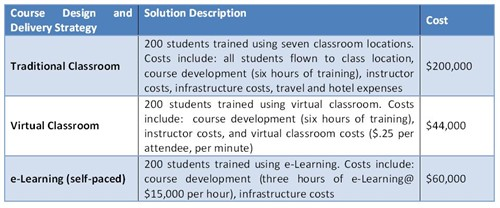How Can E-learning Maximize An Organization’s ROI on Training
This blog post shares about five advantages of using online training medium to maximize the ROI of your training programs.

The main purpose of training is to improve business performance by increasing revenue and reducing costs.Organizations spend billions on employee training and development programs because imparting effective training helps companies enhance the knowledge, skills and capabilities of their employees, thereby enhancing their productivity.
It is common knowledge that all firms try to get the best Return on Investment (ROI) on their L&D initiatives. We can maximize the ROI on training, using eLearning. According to a report released by IBM, companies who utilize eLearning tools and strategies have the potential to boost productivity by up to 50%. For every $1 that a company spends, it’s estimated that it can receive $30 worth of productivity.
Here, I would like to list 5 advantages of using the online training medium.
1. Saves time
British Telecom delivered e-business training to 23,000 employees in three months at a cost of £5.9m, compared to £17.8 million and a five-year time span for classroom training (Source: Taylor, 2002).
As eLearning is asynchronous innature, it reduces the time to rollout updates. E-learning materials can be updated quickly online and hosted at a central repository, where employees can access the updated materials. Furthermore, learners don’t have to travel to take online courses. This saves considerable time and money.

2. Delivers cost-effective training
Companies save about 50% to 70% on training, when they replace instructor-led training sessions with eLearning courses, due to reduced or eliminated travel costs and more targeted training (IOMA 2002).
With the help of rapid authoring tools, eLearning courses can be developed cost-effectively to improve performance and provide opportunities for growth and development. For example,a 60 minuteonline course can be developed in about 3-4 weeks using rapid authoring tools.

3. Offers Flexibility
E-learning is highly flexible. Online courses can be delivered, anytime, anywhere, on any device, allowing learners to access courses conveniently. Furthermore, online courses can be translated into multiple languages, quickly, at low cost.

4. Maintain Consistency
As eLearning is asynchronous and self-paced,it ensures consistency in the format and delivery of content. This goes a long way in motivating employees to take the course. With consistency and standardization, a high quality eLearning course can be delivered to the employees.

5. Allows Tracking
E-learning allows employees to know where they are in the course and how much they learned.
It allows organizations to track the performance of their employees. With an LMS, organizations can improve the efficiency of eLearning courses and online training programs.

Let’s compare eLearning with other modes of learning.

(Source: http://www.trainingindustry.com/content-development/articles/understanding-the-roi-of-elearning.aspx)
Thus, we see that eLearning is the best training methodologyand organizations can use the online training medium to improve their performance by increasing revenues and decreasing costs. Please share your thoughts!





